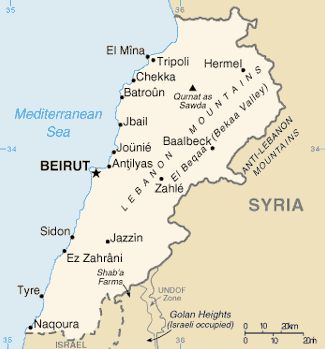Energy in Lebanon
Primary energy use in 2009 in Lebanon was 77 TWh and 18 TWh per million persons.[1] The great majority of energy used in the country comes from oil.[2] Lebanon imports most of its energy.

As of August 2016, electricity generation capacity in Lebanon still does not meet the country's demand. The country suffers frequent blackouts,[3] and many households and businesses rely on diesel generators for electricity.[4] Lebanon is also importing electricity from Syria. Domestic electricity is delivered at 230 V 50 Hz.
Overview
| Capita | Prim. energy | Production | Import | Electricity | CO2-emission | |
|---|---|---|---|---|---|---|
| Million | TWh | TWh | TWh | TWh | Mt | |
| 2004 | 3.54 | 63 | 3 | 60 | 8.85 | 15.29 |
| 2007 | 4.10 | 46 | 2 | 46 | 8.97 | 11.35 |
| 2008 | 4.14 | 61 | 2 | 61 | 9.51 | 15.23 |
| 2009 | 4.22 | 77 | 2 | 78 | 13.14 | 19.33 |
| Change 2004-2009 | 19% | 23% | -26% | 29% | 48% | 26% |
| Mtoe = 11.63 TWh, Prim. energy includes energy losses. | ||||||
Gas
The Arab Gas Pipeline is a natural gas pipeline exporting Egyptian natural gas to Jordan, Syria and Lebanon, with a separate line to Israel.
Renewable energy
The Lebanese government intends to meet 12 percent target of its total energy needs from renewable energy sources by 2020.[6]
See also
| Wikimedia Commons has media related to Energy in Lebanon. |
- Trans-Arabian Pipeline
- Renewable energy by country
References
- IEA Key energy statistics 2011 Archived 2011-10-27 at the Wayback Machine Page: Country specific indicator numbers from page 48
- "Lebanon - Countries & Regions - IEA". IEA. Retrieved 6 July 2020.
- "Lebanon energy plan". Power Technology | Energy News and Market Analysis. 24 May 2019. Retrieved 6 July 2020.
- Moore, Henrietta L.; Collins, Hannah (February 2020). "Decentralised renewable energy and prosperity for Lebanon". Energy Policy. 137: 111102. doi:10.1016/j.enpol.2019.111102.
- IEA Key World Energy Statistics 2011, Archived 2011-10-27 at the Wayback Machine 2010, Archived 2010-10-11 at the Wayback Machine 2009, Archived 2013-10-07 at the Wayback Machine 2006 Archived 2009-10-12 at the Wayback Machine IEA October, crude oil p.11, coal p. 13 gas p. 15
- Daily Star article on geothermal energy in Lebanon